Quasiperiodic Oscillations and Dynamics of Test Particles around Quasi- and Non-Schwarzschild Black Holes
Abstract
:1. Introduction
2. “Deformed” Black Hole Solutions
2.1. Quasi-Schwarzschild Black Holes
2.2. Non-Schwarzschild Black Holes
3. Motion of Test Particles
4. Fundamental Frequencies of Oscillating Particles in the Deformed Spacetimes
4.1. Keplerian Frequency
4.2. Harmonic Oscillations
5. Quasiperiodic Oscillations in Relativistic Precession Model
QPO Orbits
6. Astrophysical Applications
6.1. Deformed Black Hole Mimickers
6.2. Constraints on the BH Mass and Deviation Parameters
6.3. GRO J1655-40
6.4. GRS 1915+105
7. Conclusions
Author Contributions
Funding
Institutional Review Board Statement
Informed Consent Statement
Data Availability Statement
Acknowledgments
Conflicts of Interest
References
- Jiang, Y.F.; Greene, J.E.; Ho, L.C.; Xiao, T.; Barth, A.J. The Host Galaxies of Low-mass Black Holes. Astrophys. J. 2011, 742, 68. [Google Scholar] [CrossRef]
- Gebhardt, K.; Rich, R.M.; Ho, L.C. An Intermediate-Mass Black Hole in the Globular Cluster G1: Improved Significance from New Keck and Hubble Space Telescope Observations. Astrophys. J. 2005, 634, 1093–1102. [Google Scholar] [CrossRef]
- Celotti, A.; Miller, J.C.; Sciama, D.W. Astrophysical evidence for the existence of black holes. Class. Quantum Gravity 1999, 16, A3–A21. [Google Scholar] [CrossRef]
- Akiyama, K. et al. [Event Horizon Telescope Collaboration] First M87 Event Horizon Telescope Results. I. The Shadow of the Supermassive Black Hole. Astrophys. J. 2019, 875, L1. [Google Scholar] [CrossRef]
- Akiyama, K. et al. [Event Horizon Telescope Collaboration] First M87 Event Horizon Telescope Results. VI. The Shadow and Mass of the Central Black Hole. Astrophys. J. 2019, 875, L6. [Google Scholar] [CrossRef]
- Török, G. A possible 3:2 orbital epicyclic resonance in QPO frequencies of Sgr A*. Astron. Astrophys. 2005, 440, 1–4. [Google Scholar] [CrossRef]
- Török, G.; Abramowicz, M.A.; Kluźniak, W.; Stuchlík, Z. The orbital resonance model for twin peak kHz quasi periodic oscillations in microquasars. Astron. Astrophys. 2005, 436, 1–8. [Google Scholar] [CrossRef]
- Rayimbaev, J.; Abdujabbarov, A.; Abdulkhamidov, F.; Khamidov, V.; Djumanov, S.; Toshov, J.; Inoyatov, S. Quasiperiodic oscillation around charged black holes in Einstein-Maxwell-scalar theory. Eur. Phys. J. C 2022, 82, 1110. [Google Scholar] [CrossRef]
- Rayimbaev, J.; Pantig, R.C.; Övgün, A.; Abdujabbarov, A.; Demir, D. Quasiperiodic oscillations, weak field lensing and shadow cast around black holes in Symmergent gravity. Ann. Phys. 2023, 454, 169335. [Google Scholar] [CrossRef]
- Rayimbaev, J.; Ahmedov, B.; Bokhari, A.H. Constraints on charged black hole parameters using quasiperiodic oscillations data. Int. J. Mod. Phys. D 2022, 31, 2240004. [Google Scholar] [CrossRef]
- Rayimbaev, J.; Tadjimuratov, P.; Abdujabbarov, A.; Ahmedov, B.; Khudoyberdieva, M. Dynamics of Test Particles and Twin Peaks QPOs around Regular Black Holes in Modified Gravity. Galaxies 2021, 9, 75. [Google Scholar] [CrossRef]
- Rayimbaev, J.; Abdujabbarov, A.; Wen-Biao, H. Regular nonminimal magnetic black hole as a source of quasiperiodic oscillations. Phys. Rev. D 2021, 103, 104070. [Google Scholar] [CrossRef]
- Narzilloev, B.; Rayimbaev, J.; Shaymatov, S.; Abdujabbarov, A.; Ahmedov, B.; Bambi, C. Can the dynamics of test particles around charged stringy black holes mimic the spin of Kerr black holes? Phys. Rev. D 2020, 102, 044013. [Google Scholar] [CrossRef]
- Bokhari, A.H.; Rayimbaev, J.; Ahmedov, B. Test particles dynamics around deformed Reissner-Nordström black hole. Phys. Rev. D 2020, 102, 124078. [Google Scholar] [CrossRef]
- Juraeva, N.; Rayimbaev, J.; Abdujabbarov, A.; Ahmedov, B.; Palvanov, S. Distinguishing magnetically and electrically charged Reissner-Nordström black holes by magnetized particle motion. Eur. Phys. J. C 2021, 81, 70. [Google Scholar] [CrossRef]
- Rayimbaev, J.; Majeed, B.; Jamil, M.; Jusufi, K.; Wang, A. Quasiperiodic oscillations, quasinormal modes and shadows of Bardeen-Kiselev Black Holes. Phys. Dark Universe 2022, 35, 100930. [Google Scholar] [CrossRef]
- Berti, E.; Barausse, E.; Cardoso, V.; Gualtieri, L.; Pani, P.; Sperhake, U.; Stein, L.C.; Wex, N.; Yagi, K.; Baker, T.; et al. Testing general relativity with present and future astrophysical observations. Class. Quantum Gravity 2015, 32, 243001. [Google Scholar] [CrossRef]
- Moffat, J.W.; Toth, V.T. Testing Modified Gravity with Globular Cluster Velocity Dispersions. Astrophys. J. 2008, 680, 1158–1161. [Google Scholar] [CrossRef]
- Pani, P.; Cardoso, V. Are black holes in alternative theories serious astrophysical candidates? The case for Einstein-dilaton-Gauss-Bonnet black holes. Phys. Rev. D 2009, 79, 084031. [Google Scholar] [CrossRef]
- Hu, A.; Huang, G. Chaos in a Magnetized Brane-World Spacetime Using Explicit Symplectic Integrators. Universe 2022, 8, 369. [Google Scholar] [CrossRef]
- Yang, D.; Cao, W.; Zhou, N.; Zhang, H.; Liu, W.; Wu, X. Chaos in a Magnetized Modified Gravity Schwarzschild Spacetime. Universe 2022, 8, 320. [Google Scholar] [CrossRef]
- Lu, X.; Xie, Y. Gravitational lensing by a quantum deformed Schwarzschild black hole. Eur. Phys. J. C 2021, 81, 627. [Google Scholar] [CrossRef]
- Lin, H.Y.; Deng, X.M. Bound Orbits and Epicyclic Motions around Renormalization Group Improved Schwarzschild Black Holes. Universe 2022, 8, 278. [Google Scholar] [CrossRef]
- Gao, B.; Deng, X.M. Dynamics of charged test particles around quantum-corrected Schwarzschild black holes. Eur. Phys. J. C 2021, 81, 983. [Google Scholar] [CrossRef]
- Gao, Y.X.; Xie, Y. Strong deflection gravitational lensing by an Einstein–Lovelock ultracompact object. Eur. Phys. J. C 2022, 82, 162. [Google Scholar] [CrossRef]
- Zhang, J.; Xie, Y. Probing a black-bounce-Reissner–Nordström spacetime with precessing and periodic motion. Eur. Phys. J. C 2022, 82, 854. [Google Scholar] [CrossRef]
- Lin, H.Y.; Deng, X.M. Precessing and periodic orbits around Lee–Wick black holes. Eur. Phys. J. Plus 2022, 137, 176. [Google Scholar] [CrossRef]
- Yang, D.; Liu, W.; Wu, X. Impact of electric charges on chaos in magnetized Reissner–Nordström spacetimes. Eur. Phys. J. C 2023, 83, 357. [Google Scholar] [CrossRef]
- Liu, C.; Wu, X. Effects of Coupling Constants on Chaos of Charged Particles in the Einstein–Æther Theory. Universe 2023, 9, 365. [Google Scholar] [CrossRef]
- Cardoso, V.; Lemos, J.P.S.; Yoshida, S. Quasi-Schwarzschild Black Holes and Black Quasinormal Modes. Phys. Rev. D 2008, 77, 024006. [Google Scholar] [CrossRef]
- Yoon, M.; Kwon, O.; Park, C.; Lee, B.H. Quasi-Schwarzschild black hole solutions in Horndeski theory. Phys. Rev. D 2019, 100, 084036. [Google Scholar] [CrossRef]
- Amir, M.; Ghosh, S.G.; Hendi, S.H.; Kumar, A.; Sharma, R.K. Quasi-Schwarzschild spacetimes and their thermodynamics. Phys. Rev. D 2020, 102, 044059. [Google Scholar] [CrossRef]
- Capozziello, S.; De Laurentis, M.; Luongo, O.; Paliathanasis, A. Quasi-Schwarzschild Black Hole Mimickers: A Minimal Extension of General Relativity for Astrophysics. Astrophys. Space Sci. 2014, 351, 411–422. [Google Scholar]
- Zhang, L.; Zhao, R.; Jing, J. Quasi-Schwarzschild Black Holes in Gravity’s Rainbow. Phys. Rev. D 2018, 98, 044030. [Google Scholar] [CrossRef]
- Narzilloev, B.; Rayimbaev, J.; Abdujabbarov, A.; Ahmedov, B.; Bambi, C. Dynamics of charged particles and magnetic dipoles around magnetized quasi-Schwarzschild black holes. Eur. Phys. J. C 2021, 81, 269. [Google Scholar] [CrossRef]
- Johannsen, T.; Psaltis, D. Testing the No-hair Theorem with Observations in the Electromagnetic Spectrum. I. Properties of a Quasi-Kerr Spacetime. Astrophys. J. 2010, 716, 187–197. [Google Scholar] [CrossRef]
- Johannsen, T.; Psaltis, D. Metric for rapidly spinning black holes suitable for strong-field tests of the no-hair theorem. Phys. Rev. D 2011, 83, 124015. [Google Scholar] [CrossRef]
- Berti, E.; Cardoso, V.; Gualtieri, L.; Pretorius, F.; Pen, U.L. Charged Black Holes in a Born-Infeld-Maxwell Gravity. Phys. Rev. Lett. 2009, 103, 031101. [Google Scholar] [CrossRef]
- Kokkotas, K.D.; Schmidt, B.G. Quasinormal Modes of Stars and Black Holes. Living Rev. Relativ. 1999, 2, 2. [Google Scholar] [CrossRef] [PubMed]
- Rezzolla, L.; Zhidenko, A. New parametrization for spherically symmetric black holes in metric theories of gravity. Phys. Rev. D 2014, 90, 084009. [Google Scholar] [CrossRef]
- Yunes, N.; Pretorius, F. Fundamental theoretical bias in gravitational wave astrophysics and the parametrized post-Einsteinian framework. Phys. Rev. D 2009, 80, 122003. [Google Scholar] [CrossRef]
- Atamurotov, F.; Abdujabbarov, A.; Ahmedov, B. Shadow of rotating non-Kerr black hole. Phys. Rev. D 2013, 88, 064004. [Google Scholar] [CrossRef]
- Hakimov, A.; Atamurotov, F. Gravitational lensing by a non-Schwarzschild black hole in a plasma. Astrophys. Space Sci. 2016, 361, 112. [Google Scholar] [CrossRef]
- Rayimbaev, J.R.; Ahmedov, B.J.; Juraeva, N.B.; Rakhmatov, A.S. Plasma magnetosphere of deformed magnetized neutron star. Astrophys. Space Sci. 2015, 356, 301–308. [Google Scholar] [CrossRef]
- Rayimbaev, J.; Turimov, B.; Marcos, F.; Palvanov, S.; Rakhmatov, A. Particle acceleration and electromagnetic field of deformed neutron stars. Mod. Phys. Lett. A 2020, 35, 2050056. [Google Scholar] [CrossRef]
- Liu, C.; Chen, S.; Jing, J. ROTATING NON-KERR BLACK HOLE AND ENERGY EXTRACTION. Astrophys. J. 2012, 751, 148. [Google Scholar] [CrossRef]
- Jiang, J.; Bambi, C.; Steiner, J.F. Using iron line reverberation and spectroscopy to distinguish Kerr and non-Kerr black holes. J. Cosmol. Astropart. Phys. 2015, 2015, 025. [Google Scholar] [CrossRef]
- Liu, D.; Li, Z.; Bambi, C. Testing a class of non-Kerr metrics with hot spots orbiting SgrA*. J. Cosmol. Astropart. Phys. 2015, 2015, 020. [Google Scholar] [CrossRef]
- Bambi, C. Measuring the Kerr spin parameter of a non-Kerr compact object with the continuum-fitting and the iron line methods. J. Cosmol. Astropart. Phys. 2013, 2013, 055. [Google Scholar] [CrossRef]
- Bambi, C. A Code to Compute the Emission of Thin Accretion Disks in Non-Kerr Spacetimes and Test the Nature of Black Hole Candidates. Astrophys. J. 2012, 761, 174. [Google Scholar] [CrossRef]
- Akiyama, K. et al. [Event Horizon Telescope Collaboration] First M87 Event Horizon Telescope Results. IV. Imaging the Central Supermassive Black Hole. Astrophys. J. Lett. 2019, 875, L4. [Google Scholar] [CrossRef]
- Kluzniak, W.; Abramowicz, M.A. Quasi-periodic oscillations and black hole spin. Acta Phys. Pol. B 2001, 32, 3605–3615. [Google Scholar] [CrossRef]
- Gair, J.R.; Vallisneri, M.; Larson, S.L.; Baker, J.G. Testing the no-hair theorem with observations in the electromagnetic spectrum: II. black hole images. Phys. Rev. D 2014, 90, 064016. [Google Scholar] [CrossRef]
- Abramowicz, M.A.; Kluzniak, W. Trapped oscillation modes of geometrically thick discs around black holes. Astron. Astrophys. 2001, 374, L19–L22. [Google Scholar] [CrossRef]
- Stella, L.; Vietri, M. Resonant oscillations in a torus around a black hole. Astrophys. J. 1998, 492, L59–L63. [Google Scholar] [CrossRef]
- Remillard, R.A.; McClintock, J.E. X-ray properties of black-hole binaries. Annu. Rev. Astron. Astrophys. 2006, 44, 49–92. [Google Scholar] [CrossRef]
- Miller, J.M.; Fabian, A.C.; Wijnands, R.; Remillard, R.A.; Wojdowski, P.; Schulz, N.S.; Di Matteo, T.; Marshall, H.L.; Canizares, C.R.; Pooley, G.G. High-frequency quasi-periodic oscillations during a thermonuclear X-ray burst. Astrophys. J. Lett. 2004, 601, L143–L146. [Google Scholar] [CrossRef]
- Strohmayer, T.E.; Markwardt, C.B. Evidence for black hole spin in GRS 1915+105. Astrophys. J. 2002, 577, 337–355. [Google Scholar] [CrossRef]
- Glampedakis, K.; Babak, S. Mapping spacetimes with LISA: Inspiral of a test body in a `quasi-Kerr’ field. Class. Quantum Gravity 2006, 23, 4167–4188. [Google Scholar] [CrossRef]
- Will, C.M. The Confrontation between General Relativity and Experiment. Living Rev. Relativ. 2006, 9, 3. [Google Scholar] [CrossRef]
- Novikov, I.D.; Thorne, K.S. Astrophysics of black holes. In Proceedings of the Black Holes (Les Astres Occlus); Dewitt, C., Dewitt, B.S., Eds.; Gordon and Breach: New York, NY, USA, 1973; pp. 343–450. [Google Scholar]
- Turimov, B.; Rahimov, O. The Orbital and Epicyclic Frequencies in Axially Symmetric and Stationary Spacetime. Universe 2022, 8, 507. [Google Scholar] [CrossRef]
- Stuchlík, Z.; Kološ, M. Models of quasi-periodic oscillations related to mass and spin of the GRO J1655-40 black hole. Astron. Astrophys. 2016, 586, A130. [Google Scholar] [CrossRef]
- Stella, L.; Vietri, M.; Morsink, S.M. Correlations in the Quasi-periodic Oscillation Frequencies of Low-Mass X-ray Binaries and the Relativistic Precession Model. Astrophys. J. 1999, 524, L63–L66. [Google Scholar] [CrossRef]
- Bambi, C. Testing the nature of the black hole candidate in GRO J1655-40 with the relativistic precession model. arXiv 2013, arXiv:1312.2228. [Google Scholar] [CrossRef]
- Stuchlík, Z.; Kotrlová, A.; Török, G. Multi-resonance orbital model of high-frequency quasi-periodic oscillations: Possible high-precision determination of black hole and neutron star spin. Astron. Astrophys. 2013, 552, A10. [Google Scholar] [CrossRef]
- Stuchlík, Z.; Kološ, M. Controversy of the GRO J1655-40 Black Hole Mass and Spin Estimates and Its Possible Solutions. Astrophys. J. 2016, 825, 13. [Google Scholar] [CrossRef]
- Belloni, T.; Soleri, P.; Casella, P.; Méndez, M.; Migliari, S. High-frequency quasi-periodic oscillations from GRS 1915+105 in its C state. Mon. Not. R. Astron. Soc. 2006, 369, 305–310. [Google Scholar] [CrossRef]
- Kato, S. Mass and Spin of GRS 1915+105 Based on a Resonance Model of QPOs. Publ. Astron. Soc. Jpn. 2004, 56, L25–L28. [Google Scholar] [CrossRef]
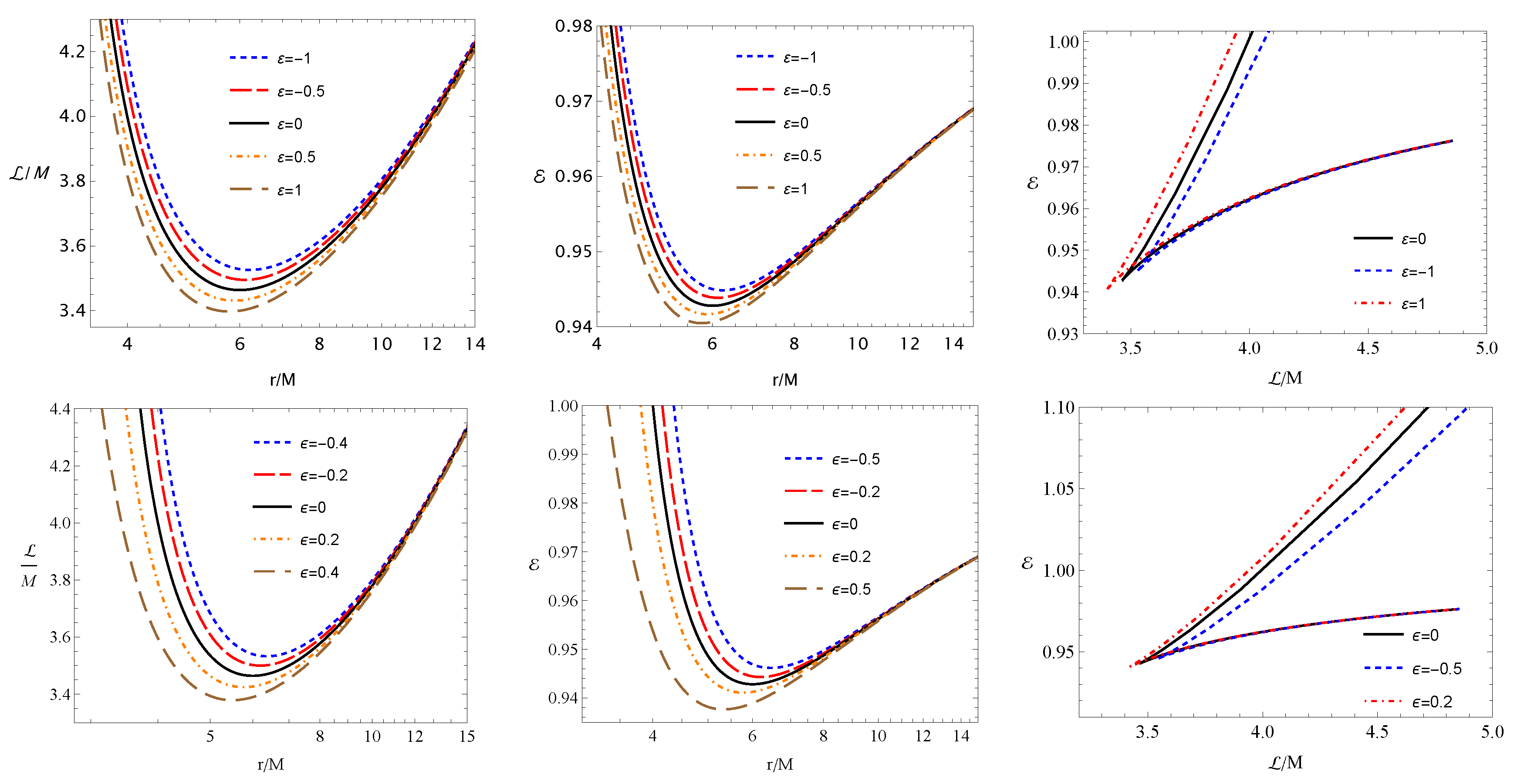
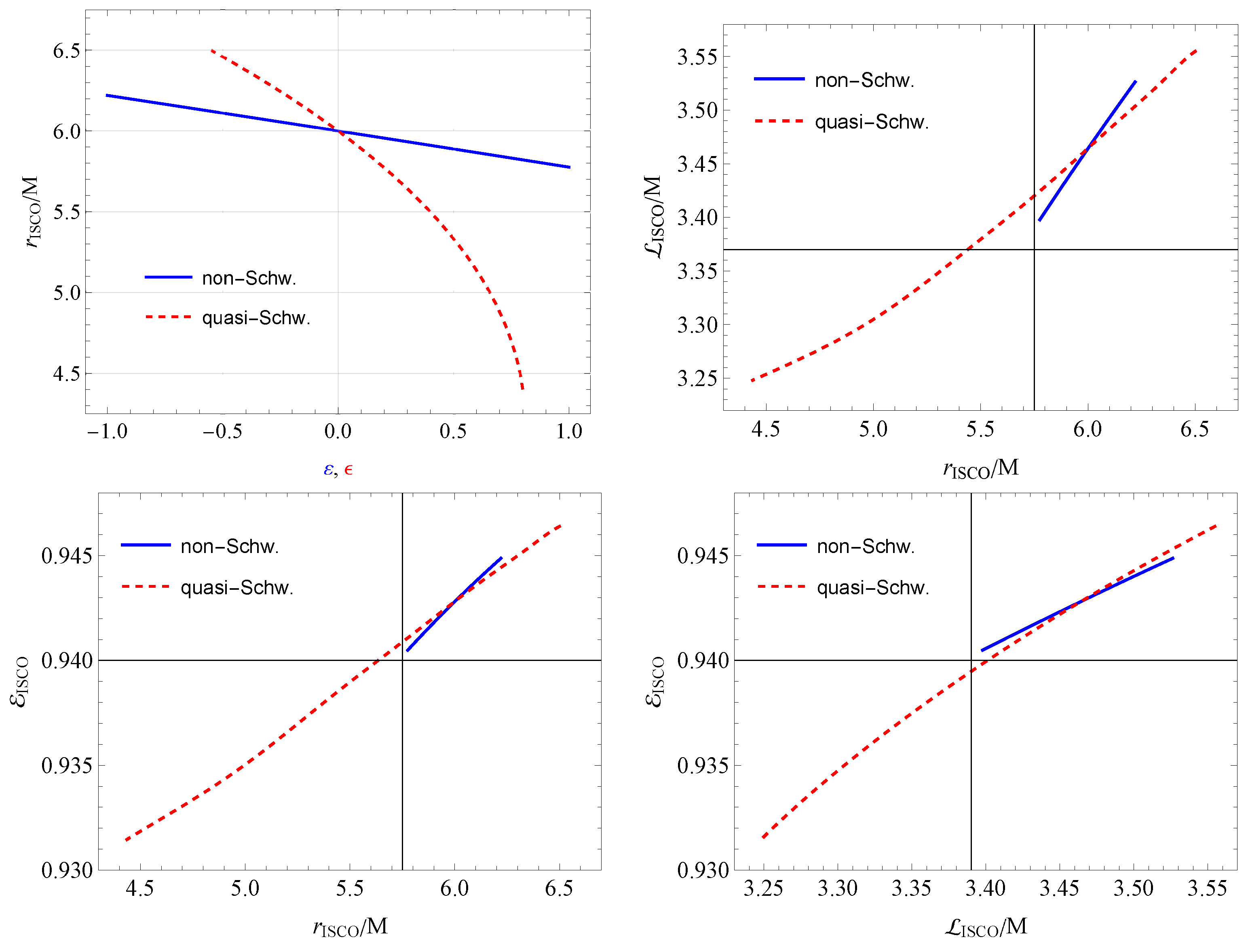



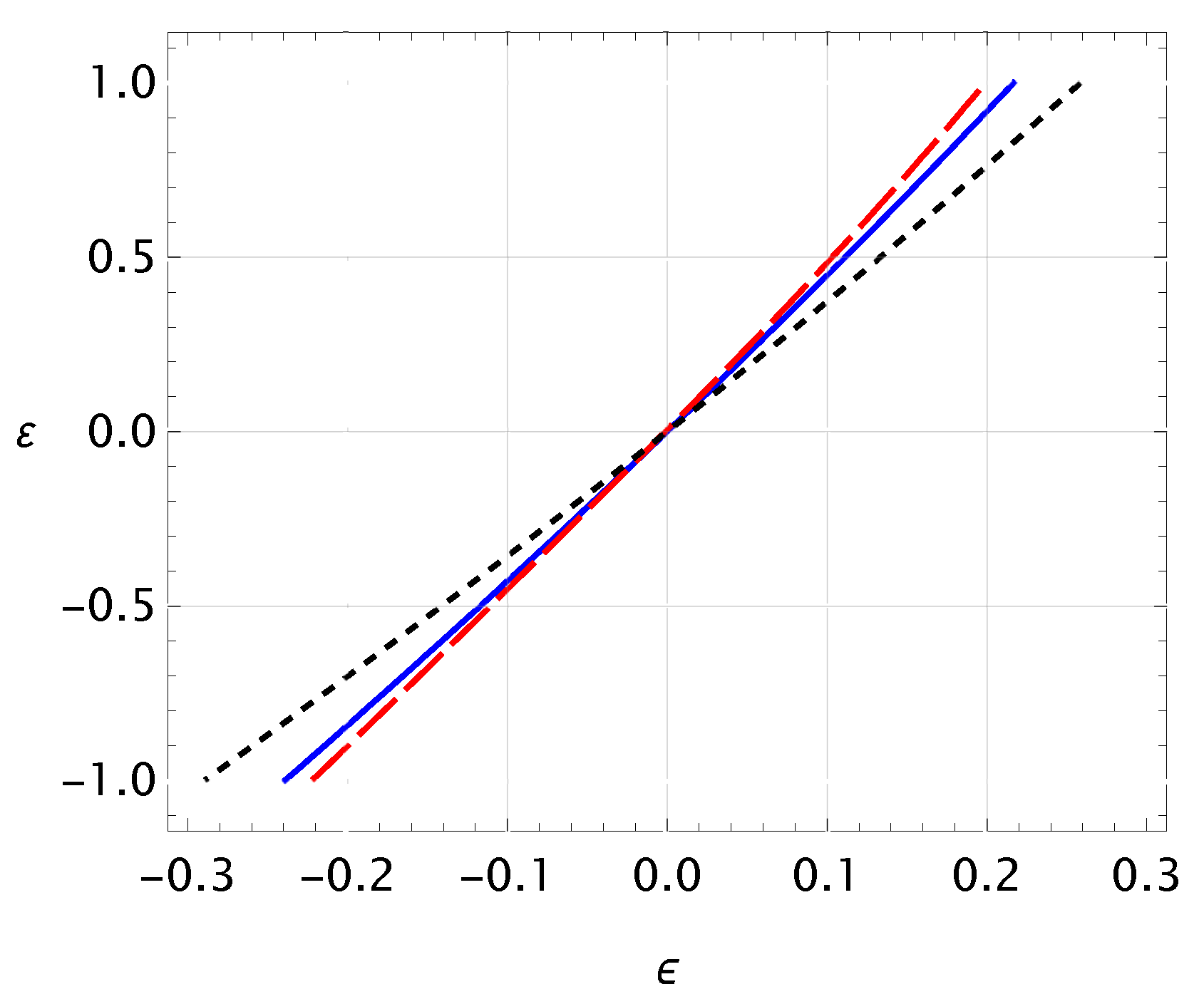
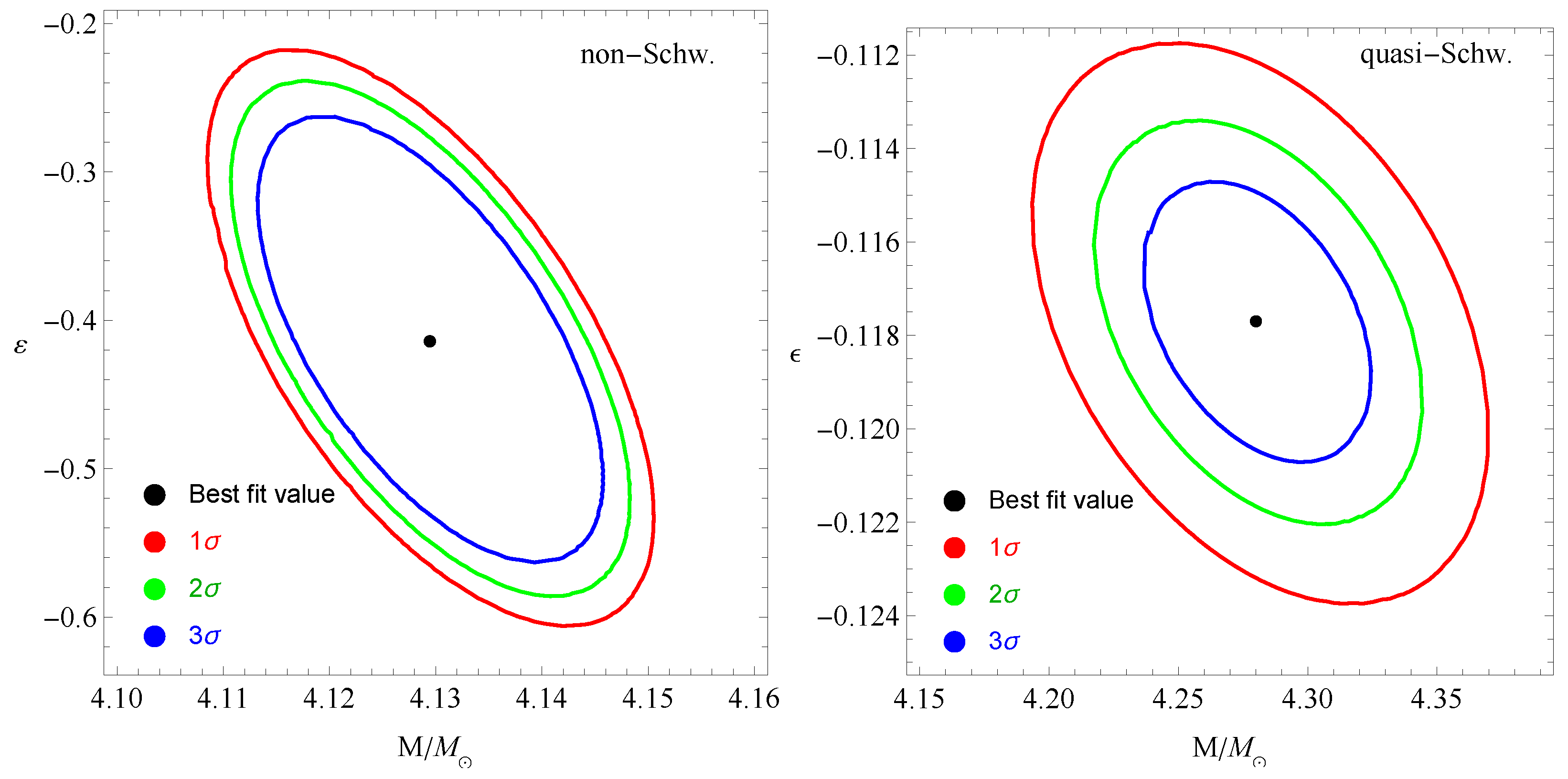
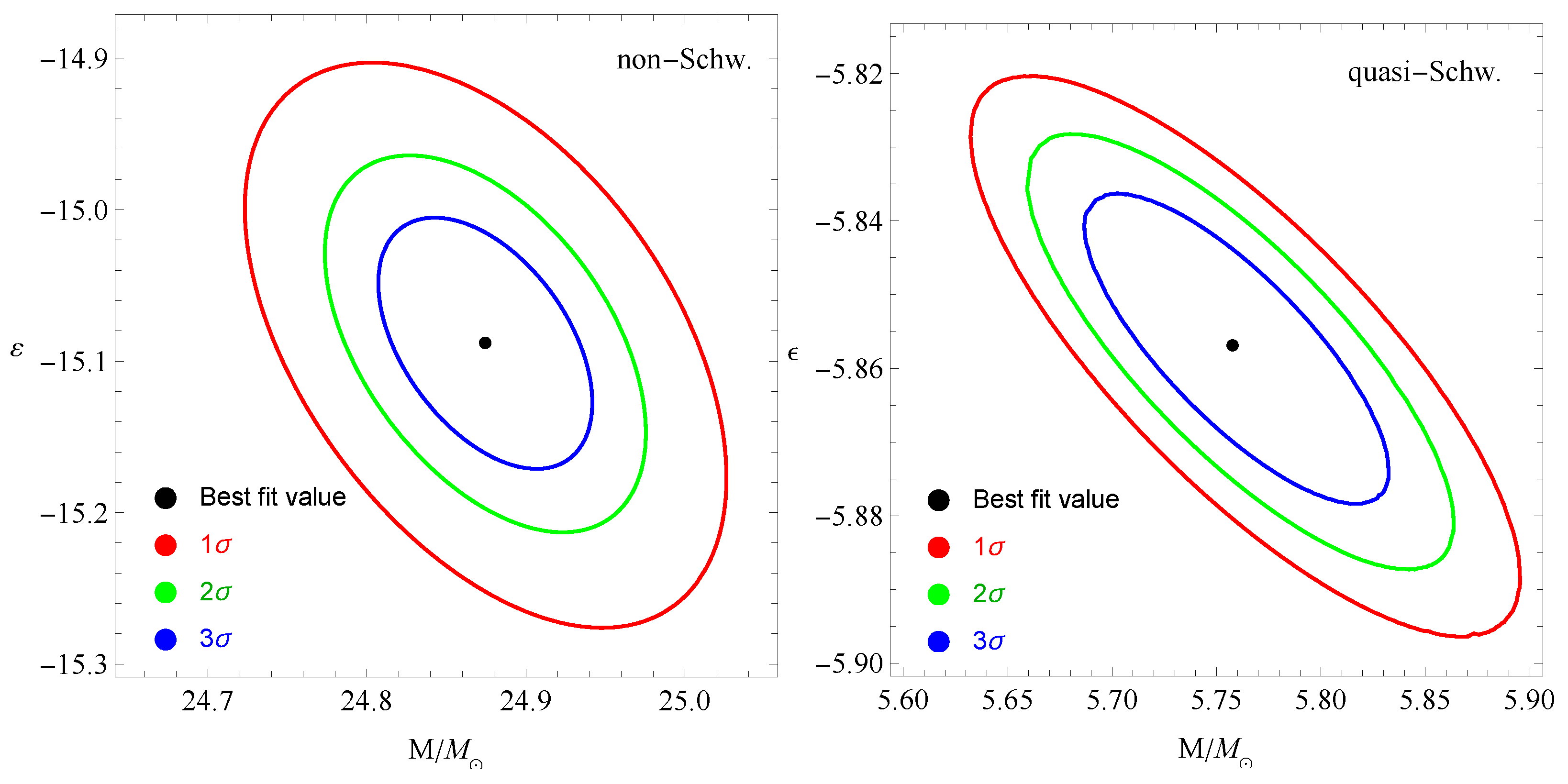
Disclaimer/Publisher’s Note: The statements, opinions and data contained in all publications are solely those of the individual author(s) and contributor(s) and not of MDPI and/or the editor(s). MDPI and/or the editor(s) disclaim responsibility for any injury to people or property resulting from any ideas, methods, instructions or products referred to in the content. |
© 2023 by the authors. Licensee MDPI, Basel, Switzerland. This article is an open access article distributed under the terms and conditions of the Creative Commons Attribution (CC BY) license (https://creativecommons.org/licenses/by/4.0/).
Share and Cite
Murodov, S.; Rayimbaev, J.; Ahmedov, B.; Karimbaev, E. Quasiperiodic Oscillations and Dynamics of Test Particles around Quasi- and Non-Schwarzschild Black Holes. Universe 2023, 9, 391. https://doi.org/10.3390/universe9090391
Murodov S, Rayimbaev J, Ahmedov B, Karimbaev E. Quasiperiodic Oscillations and Dynamics of Test Particles around Quasi- and Non-Schwarzschild Black Holes. Universe. 2023; 9(9):391. https://doi.org/10.3390/universe9090391
Chicago/Turabian StyleMurodov, Sardor, Javlon Rayimbaev, Bobomurat Ahmedov, and Eldor Karimbaev. 2023. "Quasiperiodic Oscillations and Dynamics of Test Particles around Quasi- and Non-Schwarzschild Black Holes" Universe 9, no. 9: 391. https://doi.org/10.3390/universe9090391






